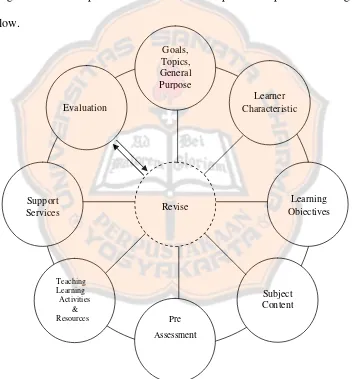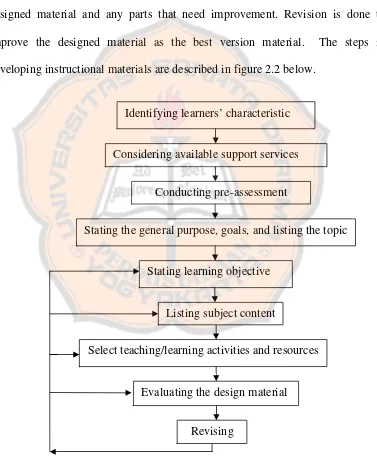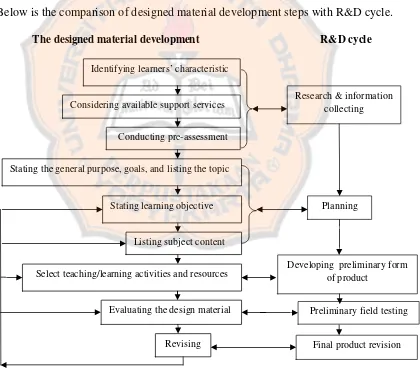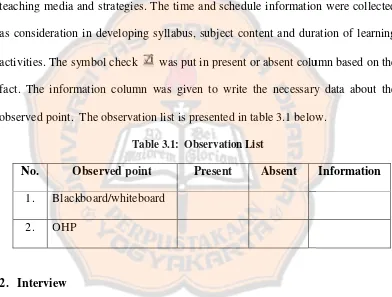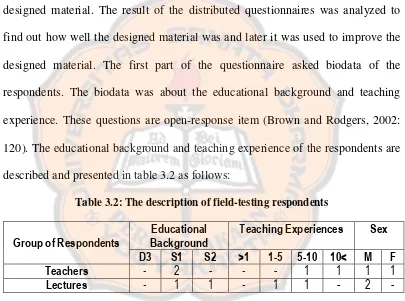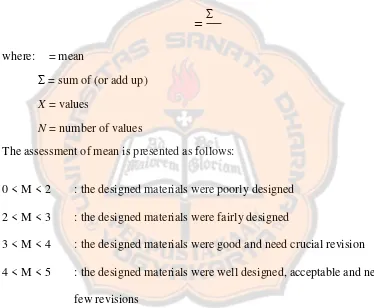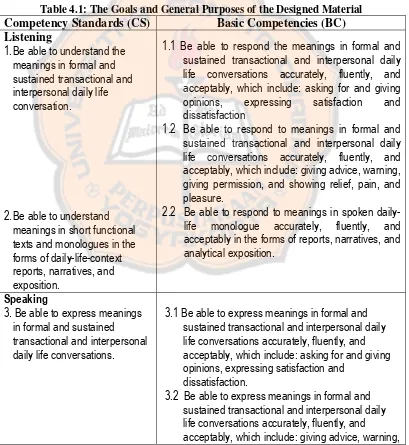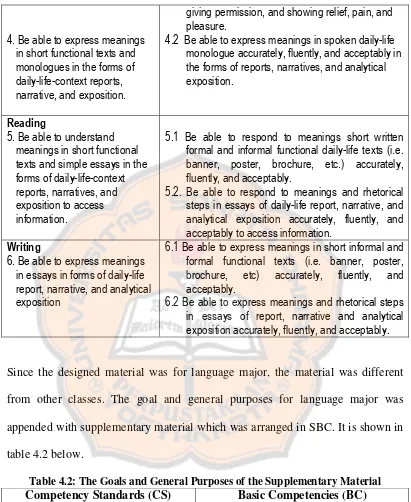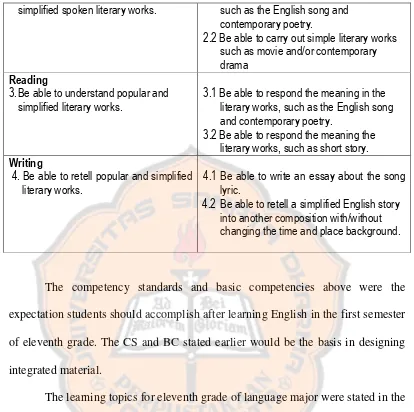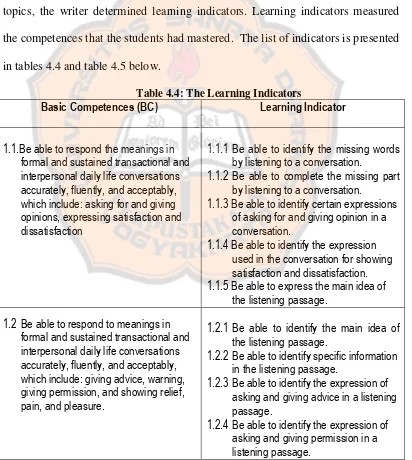i
INTEGRATED ENGLISH INSTRUCTIONAL MATERIALS BASED ON MULTIPLE INTELLIGENCE THEORY
FOR LANGUAGE MAJOR GRADE ELEVEN OFSMA SANTA MARIA
YOGYAKARTA
A THESIS
Presented as Partial Fulfillment of the Requirements to Obtain theSarjana PendidikanDegree
in English Language Education
By
Stephanie Purwanti Student Number: 051214141
ENGLISH LANGUAGE EDUCATION STUDY PROGRAM DEPARTMENT OF LANGUAGE AND ARTS EDUCATION FACULTY OF TEACHERS TRAINING AND EDUCATION
SANATA DHARMA UNIVERSITY YOGYAKARTA
iv
This study is dedicated to my parents,
vi
ACKNOWLEDGEMENTS
My deepest gratitude I devoted to My Father who always supports me when I start to be downhearted. I also express my gratitude to Ag. Hardi Prasetyo, S.Pd., M.A., my thesis sponsor, for his patience, guidance, and support so that I finally can finish this thesis.
I thank Sr. Cornelia, the headmistress ofSMA Santa Maria Yogyakartafor allowing me to conduct this research. My great appreciation also goes to my research participants: Bapak Sabas, Ibu Astuti, Antonius Jody, S.Pd., and Chosa Kastuhandani, S.Pd. for the valuable inputs, comments, and suggestions for my thesis.
I would like to appreciate all the lecturers and secretariat staff of PBI for their assistance during my study. I thank my fellows: Andre, Dion, Verdi, Bocong, Esti, Jule, Wewin, Gendis and all my classmates in PBI for wonderful time we spent and forever friendship. I never forget AKL 1 (Anak Kost Legi 1)for the support and craziness time.
My indebtedness goes to my beloved parents and sisters who never let me down in difficult situation. I dedicate my great appreciation to Yohanes Pramudiko Setiaji for his affection and concern. His critical thinking sends me back to reality that I thank him so much.
At last, I thank everyone who help and support me for this thesis that I cannot mention their name one by one.
vii
TABLE OF CONTENTS
Page
TITLE PAGE………. i
APPROVAL PAGES……… ii
DEDICATION PAGE………... iv
STATEMENT OF WORK’S ORIGINALITY……….. v
ACKNOWLDEGEMENTS………... vi
TABLE OF CONTENTS………... vii
LIST OF TABLES………. xi
LIST OF FIGURES………... xii
ABSTRACT ……….. xiii
ABSTRAK………... xiv
CHAPTER I: INTRODUCTION A. Research Background……….. 1
B. Problem Formulation……… 4
C. Problem Limitation……….. 4
D. Research Objectives………. 4
E. Research Benefits……… 5
F. Definition of Terms……….. 5
1. Integrated Material……….. 5
2. Instructional ………..………. 6
3. Multiple Intelligence Theory………. 6
viii
5. Language Major ofSMA Santa Maria Yogyakarta………. 7
CHAPTER II: LITERATURE REVIEW A. Theoretical Description……… 9
1. Kemp’s Instructional Design Model.………. 9
2. Integrated Materials………... 13
3. The Description of Language Major……….. 14
4. Multiple Intelligence Theory………. 15
a. Definition of Human Intelligence……….. 15
b. Description of the Eight Intelligences……… 16
c. Implementing MI Theory in the Classroom………... 19
1) Recognizing Students’ Intelligences………. 19
2) MI Activities Used in the Classroom………. 20
3) Deliberately Plan Lesson………... 22
4) Teachers and Students’ Role………. 23
B. Theoretical Framework………. 23
CHAPTER III: METHODOLOGY A. Research Method………. 28
1. Research and Information Collecting……….. 29
2. Planning………... 30
3. Developing Preliminary Form of Product………... 30
4. Preliminary Field Testing……… 30
5. Final Product Revision……… 31
B. Research Participants………... 32
1. Group of Research and Information Collecting……….. 32
2. Group of Field Testing……… 32
C. Research Instruments……….. 32
1. Observation Checklist………. 33
ix
3. Interview………. 33
4. Questionnaires………. 34
D. Data Gathering ……… 35
E. Data Analysis………... 36
1. Observation Checklist……… 36
2. Interview……… 36
3. Questionnaire.……… 36
F. Research Procedure……….. 40
CHAPTER IV: RESULTS AND DISCUSSIONS A. The Material Development……….. 42
1. Research and Information Collecting………. 42
a. Learners’ Characteristics……… 43
b. Available Support Service……….. 45
c. Pre-Assessment……….. 46
2. Planning……….. 47
a. Listing Basic Competencies, Competency Standards and Topics 48 b. Determining Learning Indicators……….. 51
c. Listing Subject Contents……… 54
3. Developing Preliminary Form of Product……….. 55
4. Field Testing Result……… 58
5. Main Product Revision………. 61
B. The Designed Materials……… 62
CHAPTER V: CONCLUSIONS AND SUGGESTIONS A. Conclusions……….. 64
x
REFERENCES………. 68
APPENDICES Appendix A: Surat Ijin Penelitian……….. 70
Appendix B: List of Interview Questions………. 73
Appendix C: Observation Checklist and Result……… 78
Appendix D: Research and Information Collecting Questionnaire……... 80
Appendix E: Result of Research and Information Collecting Questionnaire 84 Appendix F: MI Test ………. 88
Appendix G: Result of MI Test………. 91
Appendix H: Blue Print of Intelligences………... 94
Appendix I: Field Testing Questionnaire……….. 96
Appendix J: Teacher’s Manual……….. 99
xi
LIST OF TABLES
Table Page
3.1 Observation List ……….………. 36
3.2 The Description of Field testing Respondents………. 38
3.3 The Result of Field Testing Questionnaire……….. 39
4.1 The Goals and General Purposes of the Designed Material………… 48
4.2 The Goals and General Purposes of the Supplementary Material…… 49
4.3 The Learning Topic of Materials……….. 50
4.4 The Learning Indicators ……….. 51
4.5 The Learning Indicators for Supplementary Material ………. 53
4.6 The Learning Topics Organization ……….. 55
4.7 The MI Test Result ……….. 56
4. 8 The Background of the Respondents ………. 59
xii
LIST OF FIGURES
Figure Page
xiii ABSTRACT
Purwanti, Stephanie. 2010. Integrated English Instructional Materials Based on Multiple Intelligence Theory for Language Major Grade Eleven of SMA Santa Maria Yogyakarta. Yogyakarta: English Language Education Study Program, Sanata Dharma University.
Commonly schools only emphasize linguistic and logical-mathematical intelligences. It minimizes the importance of other forms of knowing. Thus, many students who fail traditional academic intelligences are held in low esteem and their strengths may remain unrealized and lost both the school and society at large (Gardner, 1993: xv). This study attempted to develop integrated materials based on the multiple intelligence (MI) theory for language major grade eleven of SMA Santa Maria Yogyakarta. The areas of multiple intelligences to be elaborated in this study are Linguistic, Logical-Mathematical, Visual-Spatial, Bodily-Kinesthetic, Musical, Interpersonal, Intrapersonal and Naturalist Intelligences with four intelligences served as the entry point of lesson. By implementing MI theory, students are able to recognize their own intelligence and employ it to learn English better. Not only that the students feel better about themselves and more competent, but also they can utilize the intelligence to solve problem in life.
This study was aimed at answering two research problems: (a) how a set of integrated English instructional materials based on multiple intelligence theory for language major grade eleven ofSMA Santa Maria Yogyakartais designed, and (b) what a set of integrated English materials based on multiple intelligence theory for language major grade eleven ofSMA Santa Maria Yogyakartalooks like.
In order to answer the first problem, the writer employed Kemp’s instructional design model (1977) and Borg & Gall’s (1986) Research and Development (R&D) method. Due to time and resource limitation, only five steps of R&D method were utilized, which were: (1) research and information collecting, (2) planning, (3) developing preliminary form of product, (4) field testing, and (5) final product revision.
To obtain necessary data, research and information collecting was done by conducting MI test and distributing questionnaire to 25 language major grade eleven students, teachers and students interview, and school observation. Then, the designed materials were evaluated by distributing field testing questionnaire to two teachers and two lecturers. The result was analyzed using central tendency and the mean of degree of agreement of the statements range 4-5, indicating that the designed materials were well-designed and applicable. After the writer did some revision based on the feedback and suggestions on field testing, the final product was ready to use.
The final product was served to answer the second problem, which consist of eight units. Each unit consists of two meetings, each of which contains 4 parts: ‘Snapshot’, ‘Be Ready to Roll’, ‘Walk Ahead’, and ‘Watch My Progress’.
xiv
ABSTRAK
Purwanti, Stephanie. 2010. Integrated English Instructional Materials Based on Multiple Intelligence Theory for Language Major Grade Eleven of SMA Santa Maria Yogyakarta.Yogyakarta: Program Studi Bahasa Inggris, Universitas Sanata Dharma.
Pada umumnya sekolah hanya menerapkan kecerdasan linguistik dan matematika. Hal ini meminimalkan pentingnya bentuk pembelajaran yang lain. Karenanya, banyak siswa yang gagal menunjukkan kecerdasan akademik tradisional merasa rendah diri and tidak sadar akan kekuatan mereka yang akan merugikan baik di sekolah maupun di masyrakat pada umumnya. Penelitian ini bertujuan untuk mengembangkan materi pembelajaran yang terintegrasi berdasarkan teori kecerdasan majemuk untuk siswi kelas sebelas bahasa SMA Santa Maria Yogyakarta. Area kecerdasan majemuk yang digunakan dalam penelitian ini adalah Kecerdasan Berbahasa, Kecerdasan Logis Matematis, Kecerdasan Spasial, Kecerdasan Kinestetik, Kecerdasan Musikal, Kecerdasan Interpersonal, Kecerdasan Intrapersonal, dan Kecerdasan Natural dengan empat kecerdasan sebagaientry pointdalam pelajaran.
Penelitian ini bertujuan untuk menjawab dua pertanyaan yaitu: (a) bagaimanakah cara merancang materi pembelajaran Bahasa Inggris berdasarkan teori kecerdasan majemuk untuk siswi kelas sebelas bahasa SMA Santa Maria Yogyakarta,dan (b) seperti apakah pembelajaran yang dimaksud.
Guna menjawab pertanyaan pertama, peneliti menggunakan model rancangan pembelajaran Kemp (1977) dan metode penelitian dan pengembangan (R&D) Borg & Gall (1986). Karena keterbatasan waktu dan sumber daya, hanya lima langkah dari metode penelitian dan pengembangan (R&D) yang diterapkan, yaitu: (1) pengumpulan hasil-hasil penelitian dan informasi, (2) perencanaan, (3) pengembangan bentuk awal produk, (4) uji lapangan, dan (5) revisi akhir produk.
Untuk memperoleh data-data yang diperlukan, pengumpulan hasil-hasil penelitian dan informasi dilakukan dengan melakukan tes kecerdasan majemuk dan menyebarkan kuesioner pada 25 siswi kelas sebelas bahasa, mewawancarai guru-guru dan siswi, dan melakukan pengamatan sekolah. Materi yang telah dirancang kemudian dievaluasi dengan menyebarkan kuesioner pada dua guru dan dua dosen. Hasil kuesioner dianalisa mengggunakan kecenderungan memusat (central tendency) dan nilai rata-rata tingkat kesetujuan dari pernyataan-pernyataan yang diberikan adalah 4-5, yang menunjukkan bahwa materi pembelajaran telah dirancang dengan baik dan dapat diterapkan. Setelah peneliti melakukan beberapa revisi berdasarkan saran-saran pada uji lapangan, produk akhir siap untuk digunakan.
xv
CHAPTER I
INTRODUCTION
This chapter presents the basis of the study; research background, problem formulation, problem limitation, research objectives, research benefits, and definition of terms related to the study.
A. Research Background
The rapid growth development in educational world expects greater effort for teachers to enhance students’ quality. The curriculum has been changed not only once or twice but many to find out the best suitable pillar for education in Indonesia.KTSP (Kompetensi Tingkat Satuan Pendidikan), which is also known as School Based Curriculum (SBC), is now carried out in Indonesia. It gives authority to every school in curriculum development. Schools are free to develop and select the learning objectives, learning materials, and learning methodologies that best suit their learners’ potentials, stage of development, needs, as well as the community’s demands (Act no. 20/2003 about the National Educational System). It is hoped that teachers become more creative whereby many options can be taken to decide the objectives, the most appropriate materials and strategies which enable students to perform the best.
Deciding the suitable strategies for students is not an easy work since each student covers different cognitive strength and contrasting style (Gardner, 1993:6). The way they learn is diverse in each individual. This human cognitive
competence described in terms of a set of abilities, talents or mental skills which is commonly known in terms of intelligences. In the past, people measure whether they are smart or not by taking a test. In fact, the test only measures two kinds of intelligences namely linguistic intelligence and logical-mathematical intelligence. Then, schools emphasize these two kinds of intelligences.
The restriction to focusing on certain intelligences minimizes the importance of other form of knowing. Thus, many students who fail to demonstrate the traditional academic intelligences are held in low esteem and their strength may remain unrealized and lost to both the school and society at large. Students cannot fully develop because the strategies and evaluation in learning process only covers two kinds of intelligences; linguistics intelligence and logical-mathematical intelligence.
Then, Gardner broke down people’s belief about two intelligences. Gardner conceived Multiple Intelligences Theory (MI Theory) that individual actually has at least eight distinct intelligences that can be developed over time (Gardner, 1993 as cited by Campbell, Campbell, and Dickinson, 2004: xx). Intelligences should not be limited to those two intelligences that have been identified. He considers potential new intelligences including existential, moral and spiritual intelligences (Gardner, 1993: 47).
basis for the designed material because of some reasons. Firstly, MI theory can be adapted to education system. Secondly, education has utilized MI theory as the way students learn. Thirdly, MI theory is learner centered which concerns with students and their intelligences. It encourages students to be actively involved in learning activity as well as real activity. Fourthly, the practice of MI theory is not limited by the age and environment.
Seeing the reasons above, it is possible to employ MI theory as a framework in developing materials for language major grade eleven ofSMA Santa Maria Yogyakarta. There are not many schools that provided with language major for students. SMA Santa Maria Yogyakarta considering students’ different talents and interest provides language major for their students. It is expected that students are able to develop their language ability more than science and social majors. This is the reason why language needs to be more explored in the language major. Using MI theory, teacher can maximize students’ English proficiency by providing materials and situations which encompass students’ intelligences. By doing so, students will learn language easily and comfortably, which encourage students to improve their English proficiency.
materials based on Multiple Intelligence theory for language major ofSMA Santa Maria Yogyakarta.
B. Problem Formulation
In this study, the writer formulates two problems:
1. How is the integrated English instructional material based on Multiple Intelligence theory for language major grade eleven of SMA Santa Maria Yogyakartadesigned?
2. What does the integrated English instructional material based on Multiple Intelligence theory for language major grade eleven of SMA Santa Maria Yogyakartalook like?
C. Problem Limitation
This study was limited to design the integrated English instructional materials based on Multiple Intelligence theory for language major grade eleven of SMA Santa Maria Yogyakarta. The designed material was based on SBC (School Based Curriculum). The designed material is not implemented. However, the designed material is assessed in the end by distributing questionnaire to English teachers and lecturers.
D. Research Objectives
1. to design the integrated English instructional material based on Multiple Intelligence theory for language major grade eleven of SMA Santa Maria Yogyakarta.
2. to present the integrated English instructional material based on Multiple Intelligence theory for language major grade eleven of SMA Santa Maria Yogyakarta.
E. Research Benefits
The result of this study is expected to be beneficial for English teachers in particular, especially for teachers and students of language major grade eleven of
SMA Santa Maria Yogyakarta. The designed material can be referential in teaching and learning English. Additionally, the result of this study is expected to serve as a model and guideline for teachers to develop their own materials based on multiple intelligence theory.
The writer hopes that teachers are now more concerned with students’ intelligences and are able to employ the intelligences to support teaching-learning process. By doing so, it will produce the best result of learning process. Furthermore, it is expected that students are not only able to solve problem in learning process but also in further situation in the real-world.
F. Definition of Terms
1. Integrated Material
Richards and Rodgers (2001:64) defines integrated material as learning material which focuses on the mastery of the integrated communicative skills rather than a mere mastery of the rules of the target language. Integrated material in this study refers to learning material that combines the exploration of two or more language skills in one lesson, rather than teaches each skill in isolation.
2. Instructional
The instructional process is complex. It is composed of many interrelated parts and functions that must operate in a coherent manner in order to achieve success (Kemp, 1977: 6). Banathy also defines instruction as any interaction between learners and environment through which they are making progress toward the attainment of specific purpose, knowledge, skill, and attitude (1997: 3). In this study, instructional is defined as the whole process of designing integrated English materials and all activities presented in the designed material to achieve learning objectives.
3. Multiple Intelligences Theory
The multiple intelligences are perceived as instructional process capable of enhancing students learning in any discipline (Gardner, 1993: 231). By exploring and using intelligences in each individual, students can learn in their best way to gain the best result. MI theory emphasizes the importance of students understanding and not repetition of memorizing. In this study, MI theory is used to be the basis of design development.
4. School Based Curriculum (KTSP)
SBC is the recent curriculum promoted in 2006 in Indonesia. SBC is applied in order for educational institution to be independent and initiative through the given of autonomy and supported participative taking decision in developing curriculum (Mulyasa, 2007: 22). This means school may also design a type of syllabus which is suitable for the school condition and needs. Not only that, teacher may design a lesson unit plan which is suitable for the classroom characteristics and condition. The 2006 edition of School Based Curriculum is to provide students with the communicative ability to speak English which are needed for their life. It is clear that SBC is ‘assisting learners to gain the communicative and linguistic skills they need to carry out real-world tasks’ (Nunan, 1988: 22).
5. Language Major ofSMA Santa Maria Yogyakarta
CHAPTER II
LITERATURE REVIEW
This chapter presents some theories which support this study to answer the problem stated in the previous chapter. There are two major points to be discussed in this chapter. The first one is theoretical description which discusses the relevant theories underlying the study and second is theoretical framework which focuses on the steps in developing designed material.
A. Theoretical Description
In this section, some theories related to the study will be elaborated. There are theories of instructional design model, integrated materials, the description of language major, and multiple intelligences.
1. Kemp’s Instructional Design Model
The model of instructional design presented in this study is Kemp’s model. Kemp’s instructional design is more flexible than other instructional design because the designer does not need to follow the steps in sequence. The designer can start from any step as long as the whole step is complete.
Kemp (1977:8-9) states that this model is able to answer three problems in instructional design. Those three problems are considered as the essential element of instructional design. They are objectives, activities and resources and the last is
evaluation. Kemp’s instructional design (Kemp, 1997: 8-91) consists of eight parts, as follows:
a. Determine goals, topics, and the purposes for teaching each topic
In determining instructional design, the designer should consider goals, list the topics, and state the general purposes for teaching each topic. The goals relate to broad competencies that will help learners to participate satisfactory in society (Kemp, 1997: 14). Topics are listed in sequence from simple to complex level which also considers learner’s prior knowledge and its correlation with another course. General purpose does not state precise learning objective. It expresses students’ expectation and teachers’ accomplishment.
b. Enumerate characteristics of the learners
c. Identifying the learning objectives
Specifying the objectives is the essential part as it is the outcome of the instruction. The objectives must be maintained in activities that best promote learning. That is why the designer has to beware in indicating objectives before selecting learning activities. The objectives should be measurable, and stated clearly and specifically in order to students are able to achieve it. Yet, identifying objectives requires refinements, changes, and additions as developing subsequent planning steps (Kemp, 1997: 24).
d. List the subject content
Subject content is closely related to the objectives and students’ needs. It contains content organization and task analysis. Content organization is to prepare an outline of what will be taught, while task analysis is a process to identify and specify subject content.
e. Develop pre-assessment
learn, the students are able to get familiar with the material as their interest may be aroused.
f. Select teaching-learning activities and resources
There is no fixed formula for corresponding activities to objectives. The designer should know the weakness and strength of alternatives method and various material (Kemp, 1997: 56). Thus, the designer selects teaching-learning activities and resources which enable students to accomplish the objectives with greatest possibility and in reasonable amount of time. The planning of teaching-learning activities and resources is closely related to the selection of the instructional material. The activities and resources are in the form of materials, which are selected to provide learning experience that will use the content associated with each objective.
g. Coordinate support services
h. Evaluate students’ learning
It deals with measuring the learning outcomes relating to the objectives. Since this designed material is not implemented, the evaluation is done to measure whether the designed material is acceptable or not. Evaluate students’ learning is done with the consideration to revise and reevaluate any part of instructional design that needs improvement. The evaluation process is presented in figure 2.1 below.
2. Integrated Materials
In developing English integrated material, first the writer should understand the nature of integrated materials. Integrated materials covers four
Figure 2.1: Kemp’s Instructional Design Model
Support Services
Evaluation
Learning Objectives Goals,
Topics, General Purpose
Learner Characteristic
Teaching Learning Activities
&
Resources Pre
Assessment
skills which are reading skill, writing skill, listening skill, and speaking skill, as well as grammar and vocabulary are taught in an integrated manner (Nunan, 2003: 206).
Richards and Rogers (2001: 64) stated that integrated material focuses on the mastery of integrated communicative skills rather than a mere mastery of target language. Integrated skills are needed in real life (Richards and Rogers, 2001: 208), which is why students need to be involved with activities that link those four skills.
3. The Description of Language Major
Language major is one of classes that Senior High School in Indonesia offers to students besides science and social classes. English is one of the main subjects should be taught in the class. In KTSP (Kurikulum Tingkat Satuan Pendidikan), it is stated that students learn English to be able to communicate in real life.
4. Multiple Intelligence Theory
In order to design a set of English instructional materials based on multiple intelligences theory, the writer should have knowledge about multiple intelligences theory. Therefore, in this part the writer discusses the theory of multiple intelligences namely: a definition of human intelligence, a description of the eight intelligences, and implementing MI theory in the classroom.
a. Definition of Human Intelligence
Dr. Howard Gardner, professor of Education at Harvard University has conducted researches on the development of human cognition capacities. Based on Gardner’s point of view, the common premise of intelligence theory adheres two fundamental assumptions: that cognition is unitary and that individuals can be adequately described as having a single, quantifiable intelligence (Campbell et al: xix).
Each intelligence has a developmental feature and is observable. Intelligences reveal distinctive cognitive features. The combination of each intelligence which is used in highly personal ways may bring the strength to deal with problems. Gardner’s research revealed a wider family human intelligence than was previously believed. Instead of viewing “smartness” in terms of a score on a standardized test, Gardner (1993: xv) defined intelligence as:
The ability to solve problems that one encounters in real life The ability to generate new problems to solve
The ability to make something or offer a service that is valued within one’s
b. Description of the Intelligences
A brief description of Gardner’s eight intelligences follows:
1) Linguistic Intelligence
It involves the abilities to think in words and to use language to express and appreciate complex meanings (Gardner, 1993: xvi). Writers, poets, lawyers, newscasters are among those that sees as having high linguistic intelligence. This intelligence is highly valued and rewarded at school (Kornhaber et al, 2004: 5) 2) Logical-Mathematical Intelligence
It involves components such as mathematical calculations, logical thinking, problem solving, deductive-inductive reasoning, and the discernment of patterns and relationship (Gardner, 1993: 35). This intelligence is most often associated with scientific and mathematical thinking. Scientist, accountants, engineer, and computer programmers demonstrate this intelligence. Like linguistic intelligence, logical-mathematical intelligence is emphasized at school (Kornhaber et al, 2004: 6).
3) Visual-Spatial Intelligence
4) Bodily-Kinesthetic Intelligence
It includes the ability to unite body and mind to perfect physical performances (Gardner, 1993: 67). Bodily-kinesthetic intelligence entails the potential of using one’s whole body or parts of body to solve problems and use mental abilities to coordinate bodily movements. Kinesthetic intelligence is the foundation of human knowing to experience life through sensory motor experiences. It is happened in athletes, dancers, surgeons, and craftspeople. 5) Musical Intelligence
This intelligence involves skills in the performance, composition, and appreciation of musical pattern. It can be developed in any normal individual who has had frequent exposure to music. The individuals, who posses musical intelligence, are sensitive to pitch, melody, rhythm, and tone. Those demonstrating this intelligence are composers, conductors, musicians, instrument makers, as well as sensitive listeners.
6) Interpersonal Intelligence
7) Intrapersonal Intelligence
Intrapersonal intelligence includes the thought and feelings. It refers to the ability to build an accurate perception of one and to use such knowledge in planning and directing one’s life. This intelligence deals with the ability to understand ourselves better. Some people with strong intrapersonal intelligence are theologians, psychologists, and philosophers.
8) Naturalist Intelligence
This intelligence enables human being to recognize, categorize, and draw upon certain features of environment including understand natural and human-made- systems. Skilled naturalist includes farmers, botanists, hunters, ecologist, and landscapers.
c. Implementing MI Theory in the Classroom
Learning activities based on Multiple Intelligence theory should be well-prepared. Teachers need to plan how learning process is run and what teachers and students have to do. Teachers may also seek information from the students about ways they would most like to learn. Then, having knowledge about MI activities used in the classroom, teachers are able to design deliberate lesson plan. To begin lesson planning, teachers might reflect on the concept they want to teach and identify the intelligence that most appropriate for corresponding the content. That is why, it is necessary for teachers to distinguish students’ intelligence at first. However, many teachers find it overwhelming to incorporate all eight intelligences areas in lessons. Thus, it is recommended that at least four intelligences serve as entry points into any content (Gardner, 1993: 232).
1). Recognizing Students’ Intelligences
In order to assist students to learn using MI theory, teachers should first recognize students’ intelligence that most students posses. It is required before planning the lesson. Teachers have to do observation at first. As Amstrong (1994) said (cited in Suparno, 2004), there are ways to analyze students’ intelligence which are using test, practicing to teach using MI, observing and collecting students’ documents.
From the result, the designer takes four strongest intelligences that will be used as the entry points of each lesson. The test can be seen in appendix F.
Directly teaching using MI in the classroom is another way. Teachers are able to observe students’ reaction. Students are introduced to the new learning method; using MI theory. Teachers prepare some different activities which cover combination of different intelligences. From students’ reactions and comments, teachers are able to conclude which intelligence is dominant. Using underlined dominant intelligence activities, it is hoped that students give positive advance in learning English.
Observation should be done before planning the lessons. There are two kinds of observations: observation inside the class and observation outside the class. Teachers are able to observe activities students do, things they like and do not like, their characteristics and abilities, and others which lead to description of students’ intelligence. The observation’s result will support the result of the test.
The last thing teachers can do is collecting students’ documents. The documents are all records that students have done before. It can be students’ works, list of achievements, papers, art works and others. The most important is school report from which teachers know the students’ mark in each subject. It helps teachers to discover which intelligence students have strongly.
2) MI Activities Used in the Classroom
intelligence (Christison, 1997: 9). Initially, teachers consider about the frequently used activities in the classroom and categorize them according to intelligence type (Larsen, 2000: 170). Being aware which type of intelligences being tapped in each activity, teachers can keep track of students’ development. Campbell (1996:232) suggests that teachers may also seek input from students about they would most like to learn. Below is the example of activities that fit each type of intelligence: Linguistic
Puzzles and games, storytelling, debate, drama, reading and writing poems, biography, interview, speech, presentation, talk show, short play, journals, and skits.
Logical-mathematical
Story problem, strategy game, explaining using diagram, prediction, story grids, analysis, classifications and projects.
Kinesthetic
Role-play, movement sequences, floor game, field trip, hands on art, displays, jigsaw, pantomime, sculptures, docudrama, and creating collages.
Visual-spatial
Viewing and creating movies, book cover, carton, bulletin board, dioramas, 3D diagram, mural, flip books, family tress, and exhibits.
Musical
Interpersonal
Group problem solving, service project, giving-receiving feedback, pair work, project work play, friendly letters, group research, and brainstorming.
Intrapersonal
Journal keeping, self-evaluation, diaries, personal anecdotes, autobiographies, analysis, reflections, guided imaginary and independent project.
Naturalist
Nature walks, animal report, gardening project, identification scrapbook, notice seasonal changes.
3) Deliberately Plan Lesson
4) Teachers and Students’ Role
Teachers and students have their own roles which is interrelated. The teachers’ roles will determine the role of language learners automatically (Setyadi, 2006: 19). According to Campbell (1997: 7) as cited in Ricards and Rogers (2001: 120), MI theory is not prescriptive that gives teachers a complex mental model from which to construct curriculum and improve themselves as educators. Teachers are expected to understand, master, and be committed to MI model. Teachers not only think of themselves merely as language teachers, as Christinson (1997: 12) said that they have role as the major contributor to the development of students’ intelligence.
As well as teachers, students need to see themselves engage in a process of personality development and beyond that of being successful language learners. They need to see their goals in general as the whole person: the well-rounded individuals and successful learners (Richards and Rodgers, 2001: 120). Being aware of their own intelligence, students will know how to use it and get benefits from it.
B. Theoretical Framework
The activities in designed material are developed based on MI theory. MI theory promotes the students to best learning using their own intelligences. The students are able to recognize their strength in learning. Hence, they are able to perform the best in learning process.
In constructing English instructional design material, the writer uses her own model adapted from Kemp’s model, as the framework. In this study, the writer does not do the revision after the product is implemented and evaluated as Kemp suggests, yet the revision of designed material will be conducted after questionnaires distribution to some English teachers of language major in SMA Santa Maria Yogyakarta and ESELP lecturers of Sanata Dharma. The questionnaire distribution aims to gather feedback of the designed material.
Below are the steps which are taken as the framework. However, the Kemps’ steps are flexible. The adjustment can be taken if it considers necessary. 1. Identifying learners’ characteristics
relation among students, social-economics situation, and physical and emotional handicap.
2. Considering available support services
In this step, the support services are considered before making plans of instructional method, activities, and preparing the deigned material. The support services include fund, facilities, accommodation, equipment, time and schedule to be used in the instructional material.
3. Conducting pre-assessment
In this study, pre-assessment were conducted by interviewing English teachers of language major grade eleven. It includes the information of students’ proficiency level and study background.
4. Stating the general purposes, goals, and listing the topic
5. Stating learning objective
Learning objectives are set in terms of objectives. Objectives concern with learning as the outcomes of instructions. Based on the 2006 School Based Curriculum, learning objective is presented in terms of indicators. Indicators are the elaboration of basic competences to measure students’ outcome.
6. Listing the subject contents
Before listing the subject content, the intelligences being employed in each lesson are determined. The intelligences, which are used in each lesson, are arranged in blue print of intelligence. Then, the subject contents are started to organized.
7. Select teaching/learning activities and resources
In this study, the designer selects the teaching/learning activities for the instructional material. It includes the selection of the appropriate instructional methods and instructional resources for accomplishing each objective. Then, the materials are selected to provide learning experience which associated with each objective. Supporting materials are able to motivate students and effectively explain and illustrate the subject content. The materials are selected and directly taken from certain sources or adapted and adjusted based on learners’ needs. 8. Evaluating the designed material
instructional materials. The purpose is to develop appropriate English instructional designed material. After the designed material is ready, the evaluation is conducted.
9. Revising
After the evaluation is done, the feedback and suggestions are used to revise the designed material and any parts that need improvement. Revision is done to improve the designed material as the best version material. The steps in developing instructional materials are described in figure 2.2 below.
Figure 2. 2: Steps of Developing Instructional Material Identifying learners’ characteristic
Stating the general purpose, goals, and listing the topic
Select teaching/learning activities and resources Stating learning objective
Evaluating the design material Considering available support services
Conducting pre-assessment
Revising
CHAPTER III
RESEARCH METHODOLOGY
This chapter discusses the method of this study which consists of six parts: research method, research participant, research instruments, data gathering, data analysis and research procedure.
A. Research Method
This study is to answer two problems stated in the first chapter. Firstly, how a set of integrated English instructional materials based on Multiple Intelligence theory for language major of SMA Santa Maria Yogyakarta is designed. Secondly, what a set of integrated English instructional materials based on Multiple Intelligence theory for language major of SMA Santa Maria Yogyakartalooks like. The final goal of this study is to present integrated English instructional materials based on MI theory which can be used directly by teachers at school. This study can be used as the model for other teachers who want to develop learning material based on multiple intelligence theory.
In order to achieve the goal, the writer employed the research and development cycle (R&D cycle) by Borg and Gall (1986). It is stated that educational research and development (R&D) is a process used to develop and validate educational product. The goal of which is not to discover new knowledge through basic research, yet establish product that is ready for operational use in the schools (Borg and Gall, 1986: 772). Using R&D cycle, the writer was able to
study and implement relevant research findings in developing the product, field-testing and revising the product based on the feedback of field-field-testing stage.
R&D cycle delivers ten major steps those are Research and Information Collecting, Planning, Developing Preliminary Product Form, Preliminary Field Testing, Main Product Revision, Main Field Testing, Operational Product Revision, Operational Field Testing, Final Product Revision, and Dissemination and Implementation. The R&D cycle is used to describe the material development in this chapter. However, it does not explicitly provide the important information which is needed in designing instructional material. Hence, the writer combined R&D cycle with Kemp’s design which is stated in the previous chapter because Kemp’s model has flexibility in which the designer is able to move forward and backward in material developing steps if it is considered necessarily. Considering the limited devices and time, the writer made some adjustments of the steps to be taken. In this study, the writer used five steps adapted from R&D cycle as follows: 1. Research and Information Collecting
2. Planning
The second step was planning which included three parts; determining goals, general purposes and topics, learning objectives, and subject contents (Kemp’s steps). In this study the three parts were in terms of competency standard, basic competence, and learning indicators. The writer applied MI theory in determining those three parts of planning. As the basis of designing materials, the writer used the data from research and data collecting in the earlier step. Since Indonesia refers to School Based Curriculum (SBC), then the competency standard and standard competence for designing materials are taken from SBC which is applied inSMA Santa Maria Yogyakarta.
3. Developing Preliminary Form of Product
Based on Kemp, in this step, teaching-learning activities and instructional resources which accomplished the objectives were selected. It included preparation of learning materials which were designed based on MI theory. The task instructions and activities were selected based on the available support services at school, students’ characteristics and needs, and in line with basic competencies in SBC. To guide the user to apply the designed material, teacher’s manual was provided.
4. Preliminary Field Testing
Dharma University. The feedback would be used to revise the weaknesses of the designed materials.
5. Final Product Revision
In Kemp’s, evaluation was followed by a view to revise and reevaluate any phases that need improvement. Using the feedback from earlier step, the designed material was revised to obtain more valid product. Later, the designed material was ready to apply to the classroom. The designed material could also be employed as a model for those who wanted to apply MI theory in their classroom. Below is the comparison of designed material development steps with R&D cycle.
The designed material development R&D cycle
Figure 3.1: The comparison of designed material development steps with R&D cycle
Identifying learners’ characteristic
Stating the general purpose, goals, and listing the topic
Select teaching/learning activities and resources Stating learning objective
Evaluating the design material Considering available support services
Conducting pre-assessment
Revising Listing subject content
Research & information collecting
Planning
Final product revision Preliminary field testing Developing preliminary form
B. Research Participants
In this study, the participants were divided into two groups based on its purpose which were group of research and information collecting and group of field-testing. These participants were as follows:
1. Group of Research and Information Collecting
Based on the instrument used in this step, the participants were divided into two groups. The first group would be English teachers of SMA Santa Maria Yogyakarta. They were interviewed since they were the people who considered the learners’ characteristics and background better. The second group was students of language major of SMA Santa Maria Yogyakarta. They would fill in the questionnaires and conduct MI test. The questionnaire was employed to gather data about students’ characteristic, interests and all information to support the designed material. MI test was used to determine the strongest intelligence that students possess.
2. Group of Field-Testing
Using questionnaires, the writer gathered feedback about the relevancy and practicality of designed material. Two English teachers of language major in
SMA Santa Maria Yogyakarta and two lecturers from ELESP of Sanata Dharma University were chosen to fill in the questionnaires.
C. Research Instruments
1. Observation Checklist
The observation checklist was conducted during school observation. The aim of this observation checklist was to survey supported services and devices which were available in the school. It was significant as the consideration in designing learning material based on MI theory. The information being collected was about facilities, budget, and number of students and English teachers, lesson duration, and other supported information. The observation checklist can be seen in the appendix C.
2. MI Test
MI test is a list of questions which students should choose the best response according to their character and fact. The test serves as a simple introduction to recognizing and respecting differences in intelligence among students (Campbell, 1996: xx). From the outcome of the test, the writer was able to summarize the strongest intelligence the students’ possess. By being aware of students’ intelligences, the writer was able to decide equitable subject content and activities which supported students to learn English best. The test can be seen in the appendix F.
3. Interview
questions freely by their own words. The responses were recorded by MP3 player. The questions in the interview were about students’ personal perception about English material that had been used in their school, their experiences, problems, opinions, and ideas related to English material in language major.
4. Questionnaires
Questionnaire is a set of questions used to gather information in a survey (Microsoft Encarta 2009). The questionnaire being conducted was easily and quicker filled in by circling the most appropriate option. Based on Ary et al (2002: 75), the type of questionnaire used in this study was in the form of structured/closed form and unstructured/open form in order to make the data gathering more valid.
In this study, there would be two times of questionnaires distribution: first in research and information collecting and second in field testing. The first questionnaire distribution was managed in research and information collecting to compile information about students’ characteristic, needs and background, supported facilities and devices. The information would be employed as consideration in developing designed material.
disagree which were represented in number 1 to 5. The second part was free spaces that the respondents could write the answer of two questions about comments and suggestions of the designed material. The result would be utilized to improve the designed material into better product ready to use in teaching-learning environment. The questionnaires can be seen in appendix I.
D. Data Gathering
Data gathering was conducted twice: in the research and information collecting and in field-testing.
During the observation at school, the writer filled in observation checklist to gather information about the facilities and devices that school has involving budgets, number of students, and English teachers, lesson duration, and other supported information. This information was used for deciding learning material based on MI theory. Then questionnaire was distributed to students of language major of SMA Santa Maria Yogyakarta and interview was conducted to English teachers there. Those steps above were conducted during research and information collecting to gather information about learners’ needs, knowledge background, characteristics, and other valuable information before designing integrated English instructional material based on MI theory.
E. Data Analysis The obtained Here is the detailed di 1. Observation Che From the obse device and media use teaching media and st as consideration in de activities. The symbol fact. The information observed point. The obse
No. Obser so interview can be participants were stude
Maria Yogyakarta.
d data should be presented and analyzed to d discussion:
hecklist
observation checklist, the writer collected data a used in the school. It was effective to dete strategies. The time and schedule information developing syllabus, subject content and dura bol check was put in present or absent colum ion column was given to write the necessary he observation list is presented in table 3.1 below
Table 3.1: Observation List
served point Present Absent
ard/whiteboard
ew can be applied to obtain information about behavior and expectation from other such as te 1994: 81). Interview can be quite free-wheeling a
be very like a conversation (Ary et al, 2002: students and English teachers of language majo
It was conducted to gather research a
draw conclusion.
ta about supported etermine possible ion were collected duration of learning olumn based on the ary data about the
low. ajor of SMA Santa
collecting. The interview was taken by both taping and taking notes. The data were summarized in paragraphs to further analyzing.
3. Questionnaire
The questionnaires were divided into two: during research and information collecting and field-testing. The first questionnaire was to gather information about students’ characteristics, needs, knowledge background and others important information which supported the material designing. The second questionnaire was conducted in field-testing which was to evaluate the preliminary-form product. Two English teachers ofSMA Santa Maria Yogyakarta
and two lecturers of ELESP Sanata Dharma were the participants of the second questionnaires.
In questionnaires, the questions are usually set out in very systematical way, and are answered by reading the questions, and then ticking responses, or writing in short answer (Ary et al, 2002: 124). There were two types of questionnaires being used in this study. Firstly, closed/ structured questionnaire which the participants are able to choose the response that best suit their opinion. Secondly, open/ unstructured questionnaire which enables participants to write free response in their own terms, to qualify their responses and avoid the limitation of preset categories of response (Cohen, Manion, and Marison, 2000: 248).
from their point of view and fact. There was a space for the respondents to write their own answer if the provided options did not meet their criteria. To make the information more valid, the questionnaire was completed with questions to be answered in sentences, which were comments and suggestions from the respondents.
The second questionnaire in field-testing stage was an evaluation of the designed material. The result of the distributed questionnaires was analyzed to find out how well the designed material was and later it was used to improve the designed material. The first part of the questionnaire asked biodata of the respondents. The biodata was about the educational background and teaching experience. These questions are open-response item (Brown and Rodgers, 2002: 120). The educational background and teaching experience of the respondents are described and presented in table 3.2 as follows:
Table 3.2: The description of field-testing respondents
Group of Respondents
Educational Background
Teaching Experiences Sex
D3 S1 S2 >1 1-5 5-10 10< M F
Teachers - 2 - - - 1 1 1 1
Lectures - 1 1 - 1 1 - 2
likert-scale (Brown and Rodgers, 2002: 128). Likert scale is the type of survey where respondents are asked to register their reactions on a 4 3 2 1 scale (Brown and Rodgers, 2002: 120). The writer used the mean, the most widely used measure of central tendency. The mean is the sum of all the values in a distribution divided by the number of values. The mean is commonly called the average. The formula is written as follows:
=Σ
where: = mean
Σ= sum of (or add up)
X= values
N= number of values
The assessment of mean is presented as follows:
0 < M < 2 : the designed materials were poorly designed 2 < M < 3 : the designed materials were fairly designed
3 < M < 4 : the designed materials were good and need crucial revision 4 < M < 5 : the designed materials were well designed, acceptable and need
few revisions
After the central tendency of each statement was found, the data would be presented in table 3.3 below:
Table 3.3: The Result of Field-Testing Questionnaire
No. Respondents Opinion
Frequency of Point of Agreement Central Tendency
1 2 3 4 5 N Mean
Field-testing questionnaire was provided with questions which the respondents were able to freely answer with their own words. The questions were about comments and suggestions from the respondents of the designed material. The result was summarized and described in sentences. The entire outcome from the questionnaire was employed to revise the designed material to be more effective and practical in the learning English based on MI theory.
F. Research Procedure
This part discusses the procedure of conducting this study. The procedure is adapted from R&D cycle and Kemp’s model. The procedure is described as follows:
1. Research and Information Collecting
Before designing materials, the writer needed to collect information about students’ characteristics, needs, knowledge background and others supported information. Therefore the writer conducted the observation at school, MI test, questionnaire distribution and interview for research and information collecting. The writer also studied relevant theories which were needed to support in designing integrated English instructional materials based on MI theory for language major ofSMA Santa Maria Yogyakarta.
2. Planning
3. Designing Preliminary Form of Product
The material was developed in this step which included lesson plan and learning material. Teacher’s manual was also provided as a guideline in applying the designed material. MI theory was applied in designing material. The designed material was a sample of intended material. The designed material was still open for further revision.
4. Field Testing
The preliminary form of product would be tested in order to get feedback whether it was suitable and covered students’ needs in learning situation or not. It was done by distributing field-testing questionnaire for English teachers of SMA Santa Maria Yogyakartaand the ELESP lectures of Sanata Dharma University. 5. Revising Material
CHAPTER IV
RESULTS AND DISCUSSIONS
This chapter discusses the answers to the two research questions, which are how integrated English instructional materials based on Multiple Intelligence Theory for language major ofSMA Santa Maria Yogyakartais designed and what a set of integrated English instructional materials based on Multiple Intelligences for Language major of SMA Santa Maria Yogyakartalooks like. The discussions are divided into two sections: (a) the material development and (b) the designed materials.
A. The Material Development
This part answers the first research questions, how a set of integrated English instructional materials based on Multiple Intelligence Theory for Language major of SMA Santa Maria Yogyakarta is designed. There are five steps, which are conducted during the material development, namely (1) research and information collecting, (2) planning, (3) developing preliminary form of product, (4) field testing result, and (5) main product revision.
1. Research and Information Collecting
The writer collected necessary information for developing the materials in three ways: conducting school observation, distributing questionnaires and interviewing, and conducting MI test for students. The obtained information consists of learners’ characteristic, available support service and pre-assessment.
a. Learners’ Characteristics
Learners’ characteristics were identified by distributing questionnaires to 25 students of Language major Grade XI and conducting MI test. The results of the questionnaires indicated that the students recognized the importance of learning English. The high motivation in learning English was shown from 68% of respondents who had ever followed English course before. 4% of the respondents did not agree that various activities in learning English supported the students in mastering the language. Above all, all the respondents agreed that using various intelligences would assist them in learning English and train other intelligences as well.
confidence in speaking. In other side, listening skill was chosen because the respondents assumed that it was fun and not boring.
In English learning activities, the students faced difficulties frequently. Most of the respondents as many as 72% had difficulties in learning listening skill. The respondents reckoned that listening skill was difficult because of unclear dialect and intonation. The difference between the pronunciation and written words was a problem for the students. The lack of vocabulary hindered the students to have progressive learning. This was also the reason of students’ difficulties in other skills. For 40% of students had difficulties in speaking skill and 12% in reading and writing skills. In speaking skills, the students faced difficulties in the lack of self-confidence and nervousness. From the result of the questionnaire, there were inner influences from the students themselves that became their difficulties in learning writing and reading skills, which were the difficulty to concentrate, laziness, and displeasure in learning such skills.
b. Available Support Service
The information about available support services were obtained by interviewing English teachers of language major inSMA Santa Maria Yogyakarta.
In this school, eleventh grade students were divided into three classes; science class, social class, and language major. SMA Santa Maria had three English teachers, two of them were S1 graduate and another was S2 graduate. Two English teachers were in charge in language major. All of them graduated from English Language Education Study Program of Sanata Dharma University with 27 years and 9 years teaching experiences.
Language major in eleventh grade contained 25 students. English subject was run three times a week: two meetings run for 2 x 45 minutes and one meeting only run for 1 x 45 minutes. Each class was equipped with a white board, board markers and a set of speaker. There were an English laboratory equipped with 35 listening booths, a VCD player and television, two rooms with 1 overhead projector (OHP) and computers, and a computer lab with internet connection. English literature such as magazines and story books were unavailable. English club was unavailable but there was an English wall magazine which was developed with teachers’ assistance. However, the wall magazine was not regularly present. The budget for excursion and additional learning material were taken from students’ contribution.
quite experienced. The writer concludes that the support services are ready for implementing the design material.
c. Pre-Assessment
Pre-assessment were conducted by interviewing English teachers of eleventh grade language major. The acquired information included students’ characters and needs, teaching strategies, and supported teaching media. From the result, it was known that the characters of each student in eleventh grade language major were quite different. This was because of the fact that the students came from different regional and cultures. However, these differences did not cause difficulties for teachers to deliver the material because there was good communication between teachers and students.
The level of students’ English proficiency differed from each other. Most of the students stated that they had joined English course in the past. From teachers’ opinion, their students were lack of confidence in speaking. This fact hindered the students’ process of effective learning. The lack of confidence was caused by limited vocabulary and students’ disability to construct sentences correctly in grammar. From the short interview with the students, the writer figured out that the students were afraid to make mistakes if they spoke because their grammar was not good enough. The students were strong in reading skill because they were used to face reading text. Besides that, the students could guess the meaning from the context.
environment. This was considered as the best way to teach. Overhead projector was sometimes used if the material was in power point. Watching movie and listening to songs were some strategies to foster students’ interest in learning English. Meanwhile, the wall magazine was rarely used to express students’ creativity.
Based on the students’ point of view, listening skills was quite challenging because they did not deal with listening exercise from recording frequently. Some of the students thought that speaking was not too difficult but they sometimes met difficulties in vocabulary. Nonetheless, some of them thought that speaking was a difficult task because the limited vocabularies, the incapability to form correct sentences, and lack of confidence. The students considered reading was quite an easy task because they were able to consult dictionary, whereas writing was not their favorite.
The students notified that the problem to learn English were because of their laziness and boredom of learning activities. Mostly they learnt by listening to the teachers. The students agreed that the various activities and the use of various media would foster them to learn English enthusiastically. The teachers also agreed that by applying MI theory in teaching-learning process would bring the paramount outcome for the students.
2. Planning
basic competencies (BC), the learning topics, the learning indicators and subject contents.
a. Listing Basic Competencies, Competency Standards and Topics
The goal and purpose of the formal school in Indonesia are described as Competency Standards (CS) and Basic Competencies (BC) in School Based Curriculum (SBC). Therefore, in the designed material, competency standards and basic competencies are taken from SBC and presented in table 4.1 below.
Table 4.1: The Goals and General Purposes of the Designed Material Competency Standards (CS) Basic Competencies (BC) Listening
1.Be able to understand the meanings in formal and sustained transactional and interpersonal daily life conversation.
2.Be able to understand meanings in short functional texts and monologues in the forms of daily-life-context reports, narratives, and exposition.
1.1 Be able to respond the meanings in formal and sustained transactional and interpersonal daily life conversations accurately, fluently, and acceptably, which include: asking for and giving opinions, expressing satisfaction and dissatisfaction
1.2 Be able to respond to meanings in formal and sustained transactional and interpersonal daily life conversations accurately, fluently, and acceptably, which include: giving advice, warning, giving permission, and showing relief, pain, and pleasure.
2.2 Be able to respond to meanings in spoken daily-life monologue accurately, fluently, and acceptably in the forms of reports, narratives, and analytical exposition.
Speaking
3. Be able to express meanings in formal and sustained transactional and interpersonal daily life conversations.
3.1 Be able to express meanings in formal and sustained transactional and interpersonal daily life conversations accurately, fluently, and acceptably, which include: asking for and giving opinions, expressing satisfaction and
dissatisfaction.
3.2 Be able to express meanings in formal and sustained transactional and interpersonal daily life conversations accurately, fluently, and
4. Be able to express meanings in short functional texts and monologues in the forms of daily-life-context reports, narrative, and exposition.
giving permission, and showing relief, pain, and pleasure.
4.2 Be able to express meanings in spoken daily-life monologue accurately, fluently, and acceptably in the forms of reports, narratives, and analytical exposition.
Reading
5. Be able to understand meanings in short functional texts and simple essays in the forms of daily-life-context reports, narratives, and exposition to access information.
5.1 Be able to respond to meanings short written formal and informal functional daily-life texts (i.e. banner, poster, brochure, etc.) accurately, fluently, and acceptably.
5.2. Be able to respond to meanings and rhetorical steps in essays of daily-life report, narrative, and analytical exposition accurately, fluently, and acceptably to access information.
Writing
6. Be able to express meanings in essays in forms of daily-life report, narrative, and analytical exposition
6.1 Be able to express meanings in short informal and formal functional texts (i.e. banner, poster, brochure, etc) accurately, fluently, and acceptably.
6.2 Be able to express meanings and rhetorical steps in essays of report, narrative and analytical exposition accurately, fluently, and acceptably.
Since the designed material was for language major, the material was different from other classes. The goal and general purposes for language major was appended with supplementary material which was arranged in SBC. It is shown in table 4.2 below.
Table 4.2: The Goals and General Purposes of the Supplementary Material Competency Standards (CS) Basic Competencies (BC) Listening
1.Be able to understand popular and simplified literary works.
1.1 Be able to respond the meaning in the spoken literary works, such as the English song and contemporary poetry.
1.2 Be able to understand and respond the meaning in the spoken literary works, such as movie and contemporary drama.
Speaking
simplified spoken literary works. such as the English song and contemporary poetry.
2.2 Be able to carry out simple literary works such as movie and/or contemporary drama
Reading
3.Be able to understand popular and simplified literary works.
3.1 Be able to respond the meaning in the literary works, such as the English song and contemporary poetry.
3.2 Be able to respond the meaning the literary works, such as short story. Writing
4. Be able to retell popular and simplified literary works.
4.1 Be able to write an essay about the song lyric.
4.2 Be able to retell a simplified English story into another composition with/without changing the time and place background.
The competency standards and basic competencies above were the expectation students should accomplish after learning English in the first semester of eleventh grade. The CS and BC stated earlier would be the basis in designing integrated material.
The learning topics for eleventh grade of language major were stated in the competences. Each learning topic required certain skills to achieve. The list of the topics and required skills are described in table 4.3 as follow:
Table 4.3: The Learning Topic of Materials
No. Learning Topic Required Skills
1 Asking for and giving opinion Listening, Speaking 2 Expressing satisfactory and dissatisfactory Listening, Speaking 3 Asking for and giving advice Listening, Speaking 4 Asking for and giving permission Listening, Speaking
5 Giving advice Listening, Speaking
6 Expressing relief Listening, Speaking
7 Expressing pain Listening, Speaking
8 Expressing pleasure Listening, Speaking
9 Report Listening, Reading, Speaking, Writing
